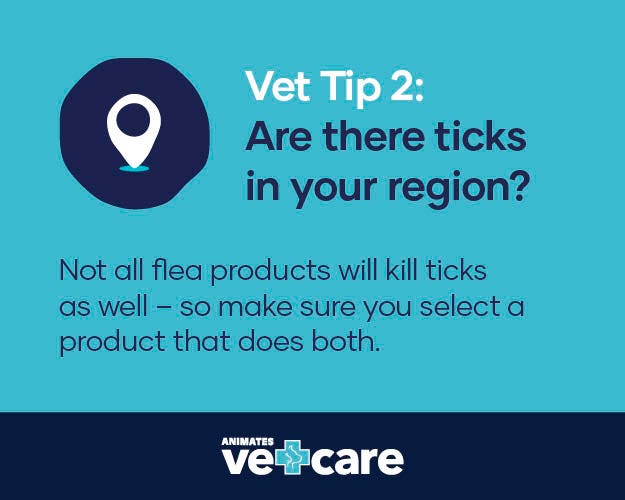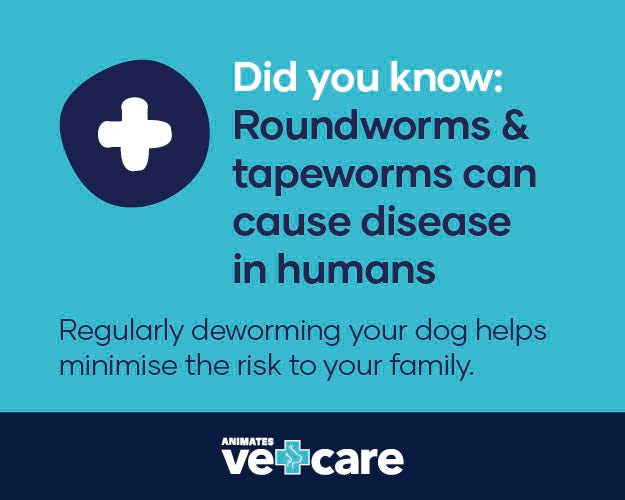How to choose the right parasite protection for your dog
There are many different types of flea, tick & worm treatments available but how do you know which one to choose? Let’s take a look at four things you need to consider when buying your canine friend’s parasite prevention treatment.
Since all dogs are unique, “one size fits all” doesn’t apply when it comes to parasite prevention. To help you choose a safe & effective safe parasite protection program for your individual pooch, there are four main factors you need to consider, which include - your dog’s age, lifestyle, weight and the treatment type.
Your Dog's Age |
When choosing a parasite protection product for your dog, it’s important to consider your dog’s age, as this will affect the products you choose and the frequency of how often your dog should be treated.
Puppy (under 6 months): Because they’re only small, and their immune systems aren’t as strong as an adult dog, taking a proactive approach to your puppy’s parasite protection is the best way to ensure they stay healthy.
- Fleas: For most puppies the first flea treatment can occur once they are six to eight weeks old - depending on the type of flea treatment chosen and the weight of your puppy. This could be in the form of a monthly chewable tablet or topical (spot-on) treatment that you apply between their shoulder blades.
- Worms: Since puppies are susceptible to intestinal worms (which can all cause serious illness), puppies should be treated for worms from two weeks of age; every two weeks until three months-old, then monthly until they’re six months old. Some products combine flea and worm treatments, like Nexgard Spectra.
Adult (over 6 months): At this point, you’ll choose a flea and worming product they can take into adulthood – the frequency will depend on product you choose, based on their lifestyle factors.

When choosing a parasite protection treatment, ensure that your puppy fits within the minimum age and weight restrictions on the packet before administering any parasite protection. If you are unsure which product would best suit your dog or puppy, just chat with your local Animates team member, who can help you find the right one.
Your Dog’s Lifestyle |
Your pet’s daily activities and exposure to the outdoors will often dictate which parasites they are most at risk from, and will determine how frequently you will need to treat your pet. Additionally, the presence of children, elderly or a family member with reduced immunity in the household are important factors to consider when choosing your dog’s parasite protection program. 
Questions you can ask yourself to determine if your dog needs monthly flea & worming treatment:
Does your dog…
- Enjoy some time at parks, beaches or doggy day-care?
- Socialise with other dogs?
- Eat raw food?
- Have contact with young children, elderly (or reduced immunity)?
If you answered “yes” to any of the questions, your dog should be having a year-round monthly flea & worming treatment.
If you answered “no” to all these questions, you can give your dog a year-round monthly flea treatment - plus a worm pill every three months (at a minimum).
Did you know? Wormicides will kill adult worms in your pet at time of treatment, but within a few days your pet can be reinfected. That is why monthly worming is important for at-risk pets.
Your Dog's Weight |
To make sure your dog receives the correct dosage; select a parasite protection treatment suited for your dog’s current weight. We recommend that you carefully check your dog’s weight before purchasing a flea or worming product, to ensure you administer the correct dosage for complete protection.
Important: Use the full dose as recommended on the label – do not split products, do not use cat products on dogs (or dog products on cats).

Treatment Type |
There are several parasite prevention treatment types available for dogs, including chewable tablets, tablets, spot-ons, flea collars, flea shampoos and sprays. When selecting a treatment type, your choice will depend on a number of considerations including: your preferences, your dog’s preferences & lifestyle and how often your dog swims or is shampooed.
Chewable tablets: Because of their delicious meaty flavour, chewable tablets are easy to administer and will kill fleas once it’s been ingested into your dog’s body. Because it’s taken internally, cuddling or swimming can be done immediately after treatment. Most dogs love chewable tablets – and think they’re a treat!
Some chewable tablet treatments such as Nexgard Spectra combine a flea, tick & worm treatment all in one, which is very convenient. Dogs will generally eat the chewable tablet without you needing to hide it in meat or cheese, too.
Spot-ons: Spot-on treatments are applied to your dog's skin between their shoulder blades on the back of their neck. These products are an easy way to protect your pet against flea infestations as they do not require your pet to swallow tablets. Spot-on treatments contain ingredients that kill fleas, and can work in a variety of ways – some stay on the skin, others are absorbed internally.
Although once applied, spot-on products may take several hours to dry. During this time, it may rinse off in water, and the residue may transfer to other pets, furniture or humans. These may not be the best option if your dog loves swimming, so be sure to follow instructions regarding application and water-fastness.
Flea collars: If your dog won’t take chewable tablets or doesn’t like topical treatments, a flea collar might be the best option. There are new technologies for flea collars such as Seresto Flea Collar for Dogs, which can provide up to eight months of flea and tick protection. While collars may be a great option for some pets, for dogs that enjoy swimming - chewable tablet may be the best option.
Tablets: While many parasite protection products kill fleas, ticks & worms, it’s important to note that some products may not treat all worms (e.g. tapeworm). If this is the case, your dog will require separate worming tablets to ensure they’re fully protected.
Flea shampoos & sprays: Flea shampoos are an easy way to deal with a dog that has an existing flea infestation (with lots of fleas visible on your pet's body). While shampoos are an effective at killing fleas while you're bathing your pooch, they are not intended for lasting control. Therefore, we recommend you use flea shampoo in conjunction with another form of flea treatment.
Note: If you’ve recently bathed your pet, it’s recommended you wait at least two days before treating them with a spot-on treatment. Additionally, it’s recommended that you avoid bathing your pet (or letting them swim) for at least three days after treatment, as this reduces its effectiveness.

Regularly treating your dog for parasites is essential to help them lead a happy and healthy life, but it can be hard to know which treatments are best for your dog. The good news is that our store teams are experts in parasite prevention and are up-to-date with the latest products – so you'll find treatments to protect dogs of all sizes and ages from these parasites.
Please note, some parasite protection products have registered claims for use in pregnant or lactating dogs.
If your dog is pregnant, lactating or has any medical conditions that may prevent you from using certain treatments and medications, we recommend you speak to the knowledgeable team at your local store or book an appointment at your local Animates Vetcare clinic for product recommendations.
Since all dogs are unique, “one size fits all” doesn’t apply when it comes to parasite prevention. To help you choose a safe & effective safe parasite protection program for your individual pooch, there are four main factors you need to consider, which include - your dog’s age, lifestyle, weight and the treatment type.
Your Dog's Age |
When choosing a parasite protection product for your dog, it’s important to consider your dog’s age, as this will affect the products you choose and the frequency of how often your dog should be treated.
Puppy (under 6 months): Because they’re only small, and their immune systems aren’t as strong as an adult dog, taking a proactive approach to your puppy’s parasite protection is the best way to ensure they stay healthy.
- Fleas: For most puppies the first flea treatment can occur once they are six to eight weeks old - depending on the type of flea treatment chosen and the weight of your puppy. This could be in the form of a monthly chewable tablet or topical (spot-on) treatment that you apply between their shoulder blades.
- Worms: Since puppies are susceptible to intestinal worms (which can all cause serious illness), puppies should be treated for worms from two weeks of age; every two weeks until three months-old, then monthly until they’re six months old. Some products combine flea and worm treatments, like Nexgard Spectra.
Adult (over 6 months): At this point, you’ll choose a flea and worming product they can take into adulthood – the frequency will depend on product you choose, based on their lifestyle factors.

When choosing a parasite protection treatment, ensure that your puppy fits within the minimum age and weight restrictions on the packet before administering any parasite protection. If you are unsure which product would best suit your dog or puppy, just chat with your local Animates team member, who can help you find the right one.
Your Dog’s Lifestyle |
Your pet’s daily activities and exposure to the outdoors will often dictate which parasites they are most at risk from, and will determine how frequently you will need to treat your pet. Additionally, the presence of children, elderly or a family member with reduced immunity in the household are important factors to consider when choosing your dog’s parasite protection program. 
Questions you can ask yourself to determine if your dog needs monthly flea & worming treatment:
Does your dog…
- Enjoy some time at parks, beaches or doggy day-care?
- Socialise with other dogs?
- Eat raw food?
- Have contact with young children, elderly (or reduced immunity)?
If you answered “yes” to any of the questions, your dog should be having a year-round monthly flea & worming treatment.
If you answered “no” to all these questions, you can give your dog a year-round monthly flea treatment - plus a worm pill every three months (at a minimum).
Did you know? Wormicides will kill adult worms in your pet at time of treatment, but within a few days your pet can be reinfected. That is why monthly worming is important for at-risk pets.
Your Dog's Weight |
To make sure your dog receives the correct dosage; select a parasite protection treatment suited for your dog’s current weight. We recommend that you carefully check your dog’s weight before purchasing a flea or worming product, to ensure you administer the correct dosage for complete protection.
Important: Use the full dose as recommended on the label – do not split products, do not use cat products on dogs (or dog products on cats).

Treatment Type |
There are several parasite prevention treatment types available for dogs, including chewable tablets, tablets, spot-ons, flea collars, flea shampoos and sprays. When selecting a treatment type, your choice will depend on a number of considerations including: your preferences, your dog’s preferences & lifestyle and how often your dog swims or is shampooed.
Chewable tablets: Because of their delicious meaty flavour, chewable tablets are easy to administer and will kill fleas once it’s been ingested into your dog’s body. Because it’s taken internally, cuddling or swimming can be done immediately after treatment. Most dogs love chewable tablets – and think they’re a treat!
Some chewable tablet treatments such as Nexgard Spectra combine a flea, tick & worm treatment all in one, which is very convenient. Dogs will generally eat the chewable tablet without you needing to hide it in meat or cheese, too.
Spot-ons: Spot-on treatments are applied to your dog's skin between their shoulder blades on the back of their neck. These products are an easy way to protect your pet against flea infestations as they do not require your pet to swallow tablets. Spot-on treatments contain ingredients that kill fleas, and can work in a variety of ways – some stay on the skin, others are absorbed internally.
Although once applied, spot-on products may take several hours to dry. During this time, it may rinse off in water, and the residue may transfer to other pets, furniture or humans. These may not be the best option if your dog loves swimming, so be sure to follow instructions regarding application and water-fastness.
Flea collars: If your dog won’t take chewable tablets or doesn’t like topical treatments, a flea collar might be the best option. There are new technologies for flea collars such as Seresto Flea Collar for Dogs, which can provide up to eight months of flea and tick protection. While collars may be a great option for some pets, for dogs that enjoy swimming - chewable tablet may be the best option.
Tablets: While many parasite protection products kill fleas, ticks & worms, it’s important to note that some products may not treat all worms (e.g. tapeworm). If this is the case, your dog will require separate worming tablets to ensure they’re fully protected.
Flea shampoos & sprays: Flea shampoos are an easy way to deal with a dog that has an existing flea infestation (with lots of fleas visible on your pet's body). While shampoos are an effective at killing fleas while you're bathing your pooch, they are not intended for lasting control. Therefore, we recommend you use flea shampoo in conjunction with another form of flea treatment.
Note: If you’ve recently bathed your pet, it’s recommended you wait at least two days before treating them with a spot-on treatment. Additionally, it’s recommended that you avoid bathing your pet (or letting them swim) for at least three days after treatment, as this reduces its effectiveness.

Regularly treating your dog for parasites is essential to help them lead a happy and healthy life, but it can be hard to know which treatments are best for your dog. The good news is that our store teams are experts in parasite prevention and are up-to-date with the latest products – so you'll find treatments to protect dogs of all sizes and ages from these parasites.
Please note, some parasite protection products have registered claims for use in pregnant or lactating dogs.
If your dog is pregnant, lactating or has any medical conditions that may prevent you from using certain treatments and medications, we recommend you speak to the knowledgeable team at your local store or book an appointment at your local Animates Vetcare clinic for product recommendations.














